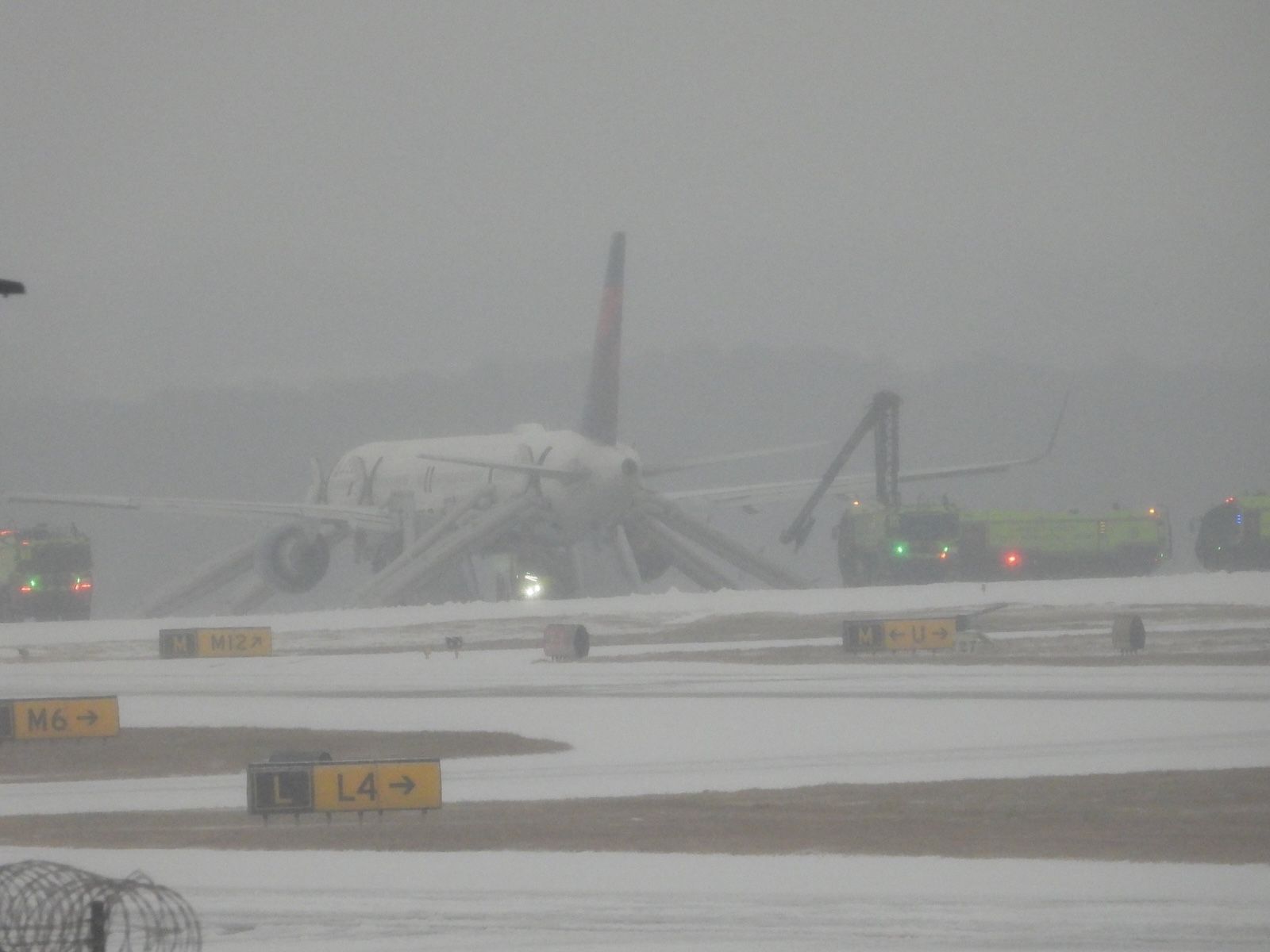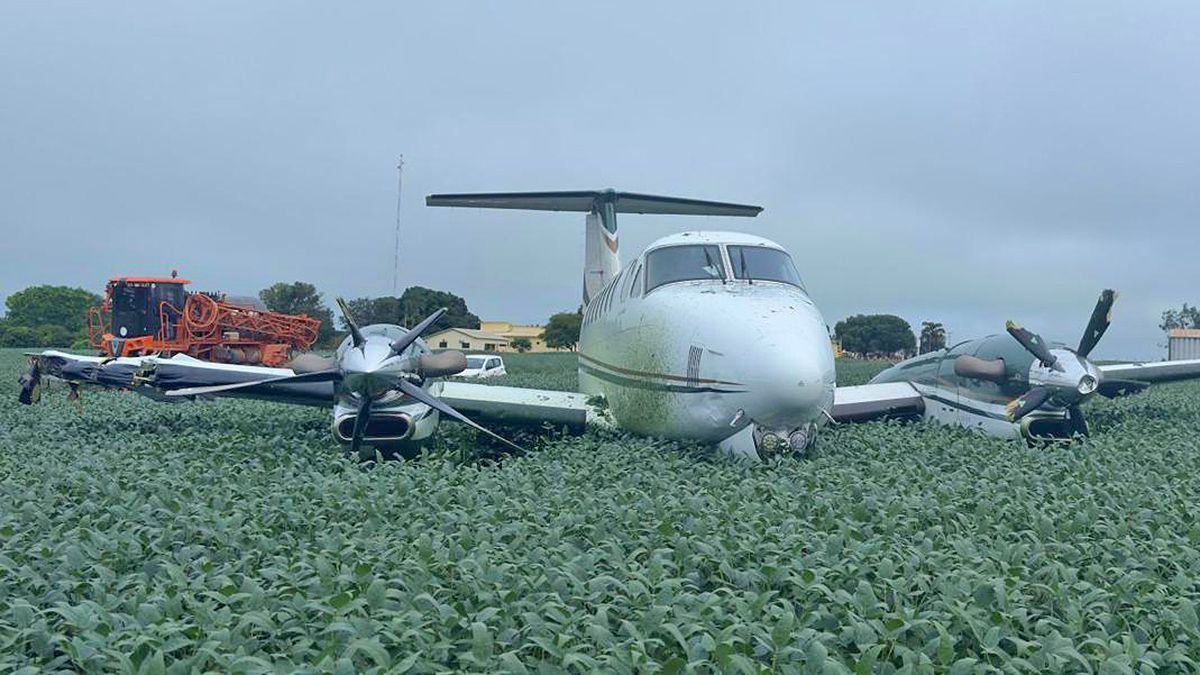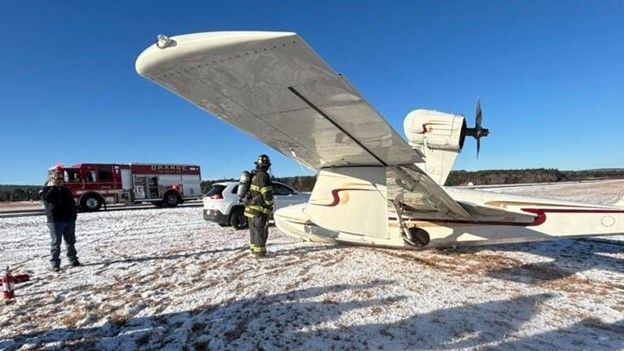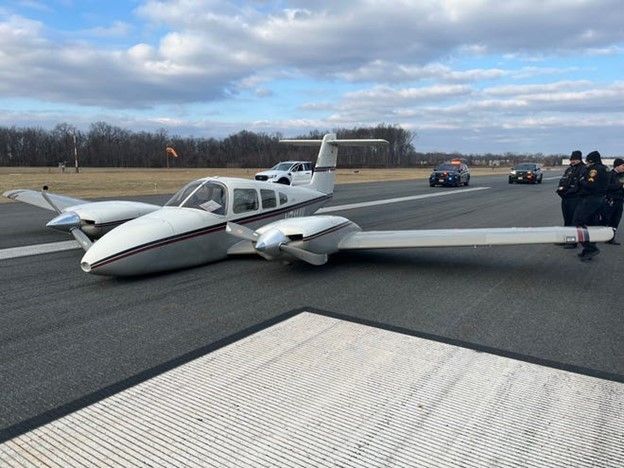ARFF Daily News
Published on:
Monday the 13th of January, 2025
Delta 757 Evacuated in Snowy Atlanta
Some minor injuries have been reported.
By Ryan Ewing
A Delta Boeing 757-300 was evacuated after an aborted takeoff in Atlanta on Friday. The evacuation followed “an indication of an engine issue,” an airline spokesperson said.
201 passengers and seven crew members were onboard. The aircraft – registered as N589NW – was operating flight 2668 to Minneapolis.
Some minor injuries have been reported. The airport is currently facing a winter weather event.
According to air traffic control audio recordings, airport crews noted smoke and flames coming from the engine. Flightradar24 ADS-B data shows the aircraft reached 85 knots before rejecting its takeoff.
“At 9:10 this morning an aircraft aborted takeoff at ATL. Passengers deplaned via emergency slides and were safely transported to a nearby concourse. Four passengers are reporting minor injuries; one was transported, the remaining three were treated on scene,” a spokesperson from the airport said in a statement.
“Operations at ATL are delayed due to the incident and the ongoing severe weather. The aircraft and the runway are expected to be cleared shortly.”
https://airlinegeeks.com/2025/01/10/delta-757-evacuated-in-snowy-atlanta/#

Emergency crews respond to Plum Island Airport for minor plane crash, 2 people on board
Boston 25 News Staff
Two people escaped injury when a small airplane crashed while practicing emergency landings at Plum Island Airport late Friday afternoon, police and fire officials said.
The two passengers reported that the single-engine Piper Warrior airplane came in to the runway too low and clipped a nearby fence with one of the plane’s wings while landing.
Emergency crews responded to Plum Island Airport around 4:55 p.m. Friday after receiving reports of a plane crash, officials said.
The plane leaked approximately six gallons of jet fuel. Firefighters cleaned the leaked jet fuel and have notified the Massachusetts Department of Environmental Protection, officials said.
The airport was closed for the night. The Federal Aviation Administration was notified of the incident.
https://www.yahoo.com/news/first-respondes-dispatched-plum-island-232017438.html

King Air plane skids off runway, loses part of wing and ends up in plantation in Mato Grosso
A King Air turboprop aircraft left the runway on Saturday afternoon (11) in the interior of Mato Grosso, damaging one of the wings and several propellers.
The Beehcraft King Air 350i aircraft, registration PR-BIH, had taken off from Confresa, in the north of Mato Grosso, close to the border with the states of Pará and Tocantins, and was heading on a short flight to another city in the region, apparently to São Félix do Araguaia.
During landing on a farm, the aircraft ended up leaving the runway, hit a structure that resembles a pole, detaching the tip of its right wing, and only stopped in a nearby plantation, with foliage covering the landing gear.
In addition to the damaged wing, several blades on the propellers of both engines were broken by impact with the ground and other objects. So far, there is no information about casualties. The news is under development.

Level-headed pilot pulls off emergency landing in Orange, officials say
An airplane landed safely at Orange Airport amidst unexpected landing gear troubles
By Darin Zullo
An airplane safely made an emergency landing at Orange Airport Sunday morning despite landing gear problems, local officials said.
Orange Fire Department dispatchers received a call around 9:30 a.m. from officials at Fitchburg Airport that a plane would be making an emergency landing at Orange Airport without its landing gear deployed, the Orange Fire Department said in a Facebook post.
The department initiated a full response with a fire engine, an ambulance, and Orange Police Department all on the scene as the plane arrived.
“As units staged, the aircraft came in and did an emergency landing on the grass and skidded to a stop,” the department said. “There was no plane crash.”
The department credited the successful landing to the skilled response from the pilot and clear communication between both airports and responding units.
“The pilot did a phenomenal job under stressful conditions resulting in no injuries, no fuel leaks, and minimal damage to the aircraft,” the department said.

They were 'very lucky': Plane lands at Essex airport without deploying landing gear
Megan Burrow - NorthJersey.com
FAIRFIELD — A small plane crashed on the runway as it was landing Sunday afternoon, police said.
Just after 2:20 p.m., police received a 911 call from Essex County Airport. Fairfield police, fire and EMS responded and found the plane, a Piper Seminole P-44, stopped on the runway without its landing gear deployed.
The pilot “failed to put the landing gear down before landing” as the plane approached the runway, said Officer Stacy Chiarolanza, public information officer for the Fairfield Police Department.
The plane “landed gear-up on its belly,” she said.
The flight instructor, a 31-year-old Paterson man, and his student, a 32-year-old man from Elizabeth, were not injured in the crash. The plane belongs to Air Fleet Training Systems at Essex County Airport, police said.
“The circumstances surrounding this crash could have been much worse, and these gentlemen are very lucky,” Chiarolanza said.
In November, a similar incident occurred when a plane skidded off the runway at the airport after its landing gear failed.
The current incident is under investigation by the Federal Aviation Administration. The airport will be closed until the investigation is complete, police said.

NTSB Final Report: Covington Edward L SHA-Glasair
An In-Flight Bird Strike Which Resulted In An Engine Compartment Fire That Ultimately Destroyed The Airplane
Location: Saint James, Minnesota Accident Number: CEN24LA267
Date & Time: July 12, 2024, 05:30 Local Registration: N3EC
Aircraft: Covington Edward L SHA-Glasair Aircraft Damage: Destroyed
Defining Event: Birdstrike Injuries: 1 None
Flight Conducted Under: Part 91: General aviation - Personal
Analysis: The pilot reported that he was on approach to land when he saw birds in his peripheral vision and then heard and felt them impact his airplane. The pilot landed, taxied to the runup pad, and shut down the engine because he smelled something burning. After exiting the airplane, he saw smoke. The pilot used the on-board fire extinguisher in an attempt to extinguish the engine compartment fire but was unsuccessful, and the fire subsequently destroyed the airplane.
Probable Cause and Findings: The National Transportation Safety Board determines the probable cause(s) of this accident to be -- An in-flight bird strike which resulted in an engine compartment fire that ultimately destroyed the airplane.
FMI: www.ntsb.gov
NTSB Final Report: ARBC Inc DBA Lindstrand 260A
The Basket Briefly Touched Down And Bounced Twice Before Coming To Rest
Location: Custer, South Dakota Accident Number: CEN24LA369
Date & Time: September 27, 2024, 07:45 Local Registration: N605KD
Aircraft: ARBC Inc DBA Lindstrand 260A Aircraft Damage: None
Defining Event: Hard landing Injuries: 1 Serious, 4 None
Flight Conducted Under: Part 91: General aviation - Aerial observation
Analysis: The pilot reported that while aligning the balloon for the landing, he became aware of increasing wind speed. He briefed the passengers for a slightly faster landing and continued the approach. The pilot stated that he made the approach to the field at 6 knots and the ground crew were able to assist in slowing down the balloon during the landing. The basket briefly touched down and bounced twice before coming to rest. During the landing a passenger sustained a serious injury. The pilot stated that the injury was a result of another passenger crushing her against the wicker partition.
The pilot reported that there were no preimpact mechanical failures or malfunctions that would have precluded normal operations.
Probable Cause and Findings: The National Transportation Safety Board determines the probable cause(s) of this accident to be -- The balloon landing in increased wind, which resulted in a hard landing and the serious injury of a passenger.
FMI: www.ntsb.gov
NTSB Prelim: Cessna 182B
The Airplane Impacted A Herd Of Sheep And Sustained Substantial Damage To The Fuselage
Location: Waimea, HI Accident Number: ANC25LA013
Date & Time: December 23, 2024, 11:00 Local Registration: N7143E
Aircraft: Cessna 182B Injuries: 2 None
Flight Conducted Under: Part 91: General aviation - Personal
On December 23, 2024, about 1100 Hawaii-Aleutian Standard time, a Cessna 182B airplane, N7143E, sustained substantial damage when it was involved in an accident near Waimea, Hawaii. The pilot and student pilot were not injured. The airplane was operated as a Title 14 Code of Federal Regulations Part 91 flight.
The instructor pilot reported that while enroute the engine “sputtered” and then lost all power. The instructor pilot made a force landing into an open field short of the runway. The airplane impacted a herd of sheep and sustained substantial damage to the fuselage. A post-accident examination by the instructor pilot revealed the left fuel tank was empty, and the right fuel tank still contained fuel.
A detailed wreckage examination is pending.
FMI: www.ntsb.gov

Today in History
43 Years ago today: On 13 January 1982 Air Florida flight 90, a Boeing 737-200, crashed into the Potomac River shortly after takeoff from Washington-National Airport, DC, USA, killing 74 occupants and 4 persons on the ground; 5 survived the accident.
Date: Wednesday 13 January 1982
Time: 16:01
Type: Boeing 737-222
Owner/operator: Air Florida
Registration: N62AF
MSN: 19556/130
Year of manufacture: 1969
Total airframe hrs: 23608 hours
Cycles: 29549 flights
Engine model: P&W JT8D-9A
Fatalities: Fatalities: 74 / Occupants: 79
Other fatalities: 4
Aircraft damage: Destroyed, written off
Category: Accident
Location: 1,4 km N of Washington-National Airport, DC (DCA) [Potomac River] - United States of America
Phase: Initial climb
Nature: Passenger - Scheduled
Departure airport: Washington-National Airport, DC (DCA/KDCA)
Destination airport: Tampa International Airport, FL (TPA/KTPA)
Investigating agency: NTSB
Confidence Rating: Accident investigation report completed and information captured
Narrative:
Air Florida flight 90, a Boeing 737-200, crashed into the Potomac River shortly after takeoff from Washington-National Airport, DC, USA, killing 74 occupants and 4 persons on the ground; 5 survived the accident.
Air Florida Flight 90 was scheduled to leave Washington National Airport at 14:15 EST for a flight to Fort Lauderdale International Airport, FL (FLL), with an intermediate stop at the Tampa, FL (TPA).
The aircraft had arrived at gate 12 as Flight 95 from Miami, FL, at 13:29. Because of snowfall, the airport was closed for snow removal from 13:38 to 14:53. At about 14:20 maintenance personnel began de-icing the left side of the fuselage with de-icing fluid Type II because the captain wanted to start the de-icing just before the airport was scheduled to reopen (at 14:30) so that he could get in line for departure. Fluid had been applied to an area of about 10 feet when the captain terminated the operation because the airport was not going to reopen at 14:30. Between 14:45 and 14:50, the captain requested that the de-icing operation be resumed.
The left side of the aircraft was de-iced first. No covers or plugs were installed over the engines or airframe openings during de-icing operations.
At 15:15, the aircraft was closed up and the jet way was retracted and the crew received push-back clearance at 15:23. A combination of ice, snow, and glycol on the ramp and a slight incline prevented the tug, which was not equipped with chains, from moving the aircraft. Then, contrary to flight manual guidance, the flight crew used reverse thrust in an attempt to move the aircraft from the ramp. This resulted in blowing snow which might have adhered to the aircraft. This didn't help either, so the tug was replaced and pushback was done at 15:35. The aircraft finally taxied to runway 36 at 15:38.
Although contrary to flight manual guidance, the crew attempted to deice the aircraft by intentionally positioning the aircraft near the exhaust of the aircraft ahead in line (a New York Air DC-9). This may have contributed to the adherence of ice on the wing leading edges and to the blocking of the engines Pt2 probes.
At 15:57:42, after the New York Air aircraft was cleared for takeoff, the captain and first officer proceeded to accomplish the pre-takeoff checklist, including verification of the takeoff engine pressure ratio (EPR) setting of 2.04 and indicated airspeed bug settings. Takeoff clearance was received at 15:58. Although the first officer expressed concern that something was 'not right' to the captain four times during the takeoff, the captain took no action to reject the takeoff. The aircraft accelerated at a lower-than-normal rate during takeoff, requiring 45 seconds and nearly 5,400 feet of runway, 15 seconds and nearly 2,000 feet more than normal, to reach lift-off speed. The aircraft initially achieved a climb, but failed to accelerate after lift-off. The aircrafts stall warning stick shaker activated almost immediately after lift-off and continued until impact. The aircraft encountered stall buffet and descended to impact at a high angle of attack. At about 16.01, the aircraft struck the heavily congested northbound span of the 14th Street Bridge and plunged into the ice-covered Potomac River. It came to rest on the west end of the bridge 0.75 nmi from the departure end of runway 36. When the aircraft struck the bridge, it struck six occupied automobiles and a boom truck before tearing away a 41-foot section of the bridge wall and 97 feet of the bridge railings. Four persons in vehicles on the bridge were killed; four were injured, one seriously.
PROBABLE CAUSE: " The flight crew's failure to use engine anti-ice during ground operation and takeoff, their decision to take off with snow/ice on the airfoil surfaces of the aircraft, and the captains failure to reject the takeoff during the early stage when his attention was called to anomalous engine instrument readings. Contributing to the accident were the prolonged ground delay between de-icing and the receipt of ATC takeoff clearance during which the airplane was exposed to continual precipitation, the known inherent pitch up characteristics of the B-737 aircraft when the leading edge is contaminated with even small amounts of snow or ice, and the limited experience of the flight crew in jet transport winter operations."

Mailing Address
Subscribe to our newsletter
Contact Us
We will get back to you as soon as possible.
Please try again later.
